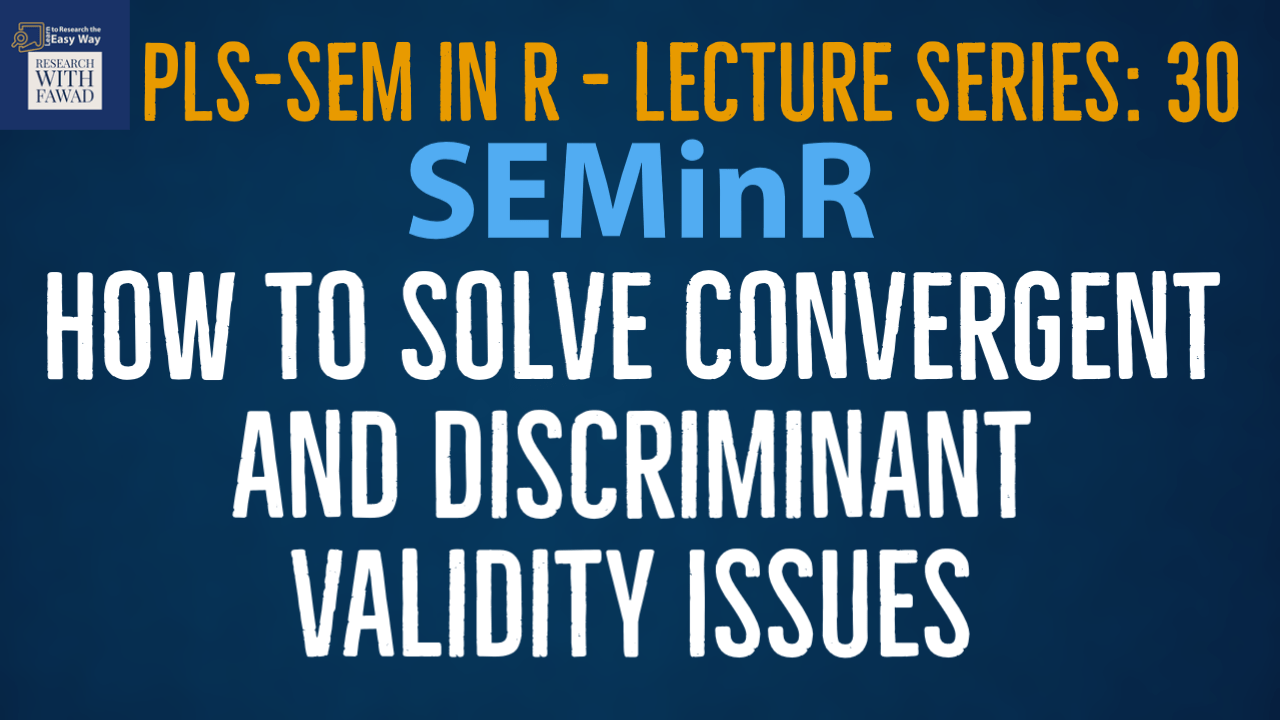How to Solve Convergent and Discriminant Validity Issues in SEMinR

SEMinR Lecture Series
This series of lectures on SEMinR Package will focus on how to solve Convergent and Discriminant Validity issues using SEMinR package in R.
Before collecting the data
- Make sure to have adequate No. of Items in each scale/construct.
- There should be at least 4-6 items, since, in SEM items are deleted if they fail to load or due to cross-loading.
- Make sure that the Items/Statements are easy to understand.
- Make sure there is no overlap in the statements of different constructs.
Recommendations
- Check for item factor loading, if item loading is too low and removing the items can substantially improve the convergent validity, remove the item.
- Although factor loading over 0.7 is desirable (Vinzi, Chin, Henseler, & Wang, 2010), researchers frequently obtain weaker outer loadings (<0.70) in social science studies. Rather than automatically eliminating indicators, the effects of the removal of the item on composite reliability, content, and convergent validity shall be examined.
- Generally, items with outer loadings from 0.40 to 0.70 shall be considered for removal only if deletion results in an increase of composite reliability or average variance extracted (AVE) over the recommended value (Hair et al., 2016).
- Check for Standard Deviation in the responses and remove responses with Standard Deviation less than 0.25.
- Check for Cross-loading, if an item is cross-loading, and the difference is less than .10, REMOVE the item(s).
What if the Problem Persists?
- If discriminant validity issues persist, no option may exist but to combine constructs into one overall measure, where correlations in the region of 0.8 to 0.9 are regularly reported in the literature between dimensions that are theoretically distinct.
- In such cases, researchers can collapse measures into a single construct, rather than conduct dimension-by-dimension analysis.
- If none of the methods presented address the issue, a researcher may have to collect additional data to determine if discriminant validity or multicollinearity issues are a result of sampling flukes.
- If problems still persist, dropping one (or more) independent variables (i.e., collinear variables that demonstrate insufficient discriminant validity) from the model may also help.
Reference
Farrell, A. M. (2010). Insufficient discriminant validity: A comment on Bove, Pervan, Beatty, and Shiu (2009). Journal of Business Research, 63(3), 324-327.
Video Tutorial (Coming Soon)
Additional SEMinR Tutorials
- An Introduction to R and R Studio
- An Introduction to SEMinR Package
- Create Project, Load, and Inspect the Data
- SEMinR Package: An Introduction to Evaluating Formative Measurement Model
- SEMinR Package: Analyzing Categorical Predictor Variables
- SEMinR Package: Bootstrapping PLS Model
- SEMinR Package: Evaluating Formative Measurement Model – Convergent Validity and Collinearity
- SEMinR Package: Evaluating Formative Measurement Model – Step 3- Indicator Weights
- SEMinR Package: Evaluating Formative Measurement Model – When to Delete Formative Indicators
- SEMinR Package: Evaluating Reflective Measurement Model
- SEMinR Package: Evaluating Structural Model
- SEMinR Package: Evaluating Structural Model – Step 4: Predictive Power (PLSPredict)
- SEMinR Package: Higher Order Analysis – REF-FOR
- SEMinR Package: Higher Order Analysis – REF-REF
- SEMinR Package: Mediation Analysis
- SEMinR Package: Moderation Analysis
- SEMinR Package: PLS Estimation
- SEMinR Package: Print, Export and Plot Results
- SEMinR Package: Reflective Measurement Model Step 2: Consistency and Step 3: Convergent Validity
- SEMinR Package: Reflective Measurement Model Step 4: Discriminant Validity
- SEMinR Package: Single Item, SmartPLS Comparison and Summary of SEMinR
- SEMinR Package: Specifying Measurement Model
- SEMinR Package: Specifying the Structural Model